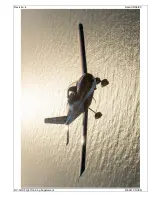
Revision: 4
Date:
09/08/20
RV-12iS Flight Training Supplement
15-5
BRAKE FAILURE
At or above approximately 15 kts, adequate steering (except in crosswinds) can be maintained with aerodynamic
rudder control.At lower speeds the RV-12iS relies at least in part on differential braking for ground steering. On any
landing the pilot has two basic goals: a) to bring the airplane to a stop and b) to keep it moving straight enough to
remain on the runway. During the higher-speed portion of the roll-out, aerodynamic rudder control is adequate for
steering.
Another steering aid in the event of a failed brake might be a crosswind. While crosswinds cause an airplane to
weathervane and turn into the wind, this turning tendency can be used to your advantage in some cases. Consider
the crosswind turning tendency to be the same as a partially-applied brake on that side of the airplane. Thus, if at
all possible, plan a landing so that the wind is coming from the side of the failed brake. Use the good brake to
counteract the turning tendency of the crosswind. This translates into heavier braking and a quicker stop.
If runway length is a problem, shut the engine off as soon as a go-around is no longer an option. This will minimize
the energy dissipation required. Holding rudder pressure opposite the good brake will permit additional force to be
applied, particularly at higher speeds. If there is a light wind or no wind, opposite rudder pressure is the only
counter force available for the good brake. This means that at low speeds, there is virtually no steering or braking
available.
Should the available runway be sufficiently long or wide, it is possible to coast to a stop within the confines of the
runway. If runway length is not available, the pilot should steer toward the dead brake side of the runway while
rudder steering control is still available. This will keep the maximum runway width available on the good brake side
so that a sharp turn can be executed to bring the airplane to a safe stop.
Possibly the worst moment for the pilot to discover a "no-brake" situation would be just as brake is applied following
touch-down. Unless there is a long, wide runway ahead, power should be applied to get the aircraft back into the
air. This would provide time to consider the options mentioned above. This also might be a good time to consider
selecting a more favorable runway or diverting to another airport with more favorable runway options. At the very
least, having time to plan for and more calmly execute a failed brake landing if likely a good option to take.
LOSS OF BLADDER/OTHER BIOLOGICAL CONTROL
If you survived all this, find a suitable facility and change your underwear.
Summary of Contents for RV 12iS
Page 1: ...Revision 4 Date 09 08 20 RV 12iS Flight Training Supplement i FLIGHT TRAINING SUPPLEMENT...
Page 14: ...Revision 4 Date 09 08 20 RV 12iS Flight Training Supplement 4 2...
Page 15: ...Revision 4 Date 09 08 20 RV 12iS Flight Training Supplement 4 3...
Page 50: ...Revision 4 Date 09 08 20 RV 12iS Flight Training Supplement 6 2 ELECTRICAL SWITCHES KNOBS...
Page 56: ...Revision 4 Date 09 08 20 RV 12iS Flight Training Supplement 6 8...
Page 89: ...Revision 4 Date 09 08 20 RV 12iS Flight Training Supplement REAR COVER...












































